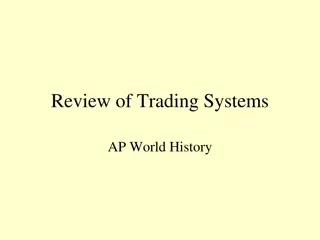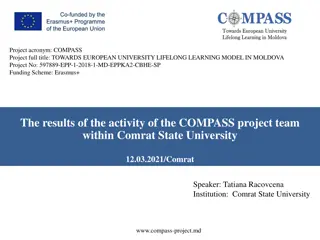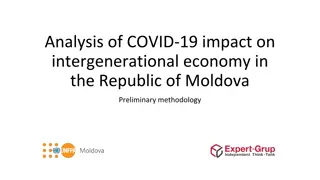Analysis of Moldova's DCFTA Impact and Strategic Trade Options
This Moldova trade study evaluates the effects of the DCFTA on Moldova using a dynamic computable general equilibrium model. Key aspects include trade data distortions removal, emphasis on trade facilitation, and comparison of strategic trade options. The study assesses different scenarios against a baseline with no trade condition changes, providing insights into the potential benefits of the DCFTA for Moldova's economy.
Download Presentation

Please find below an Image/Link to download the presentation.
The content on the website is provided AS IS for your information and personal use only. It may not be sold, licensed, or shared on other websites without obtaining consent from the author.If you encounter any issues during the download, it is possible that the publisher has removed the file from their server.
You are allowed to download the files provided on this website for personal or commercial use, subject to the condition that they are used lawfully. All files are the property of their respective owners.
The content on the website is provided AS IS for your information and personal use only. It may not be sold, licensed, or shared on other websites without obtaining consent from the author.
E N D
Presentation Transcript
Moldova Trade Study: Moldova Trade Study: IS THE DCFTA GOOD FOR MOLDOVA? IS THE DCFTA GOOD FOR MOLDOVA? Note 2 Note 2 Valeriu Prohnitchi Adrian Lupusor Chisinau, Moldova February, 29th 2016
Key aspects of the research Key aspects of the research 1. Use of a Dynamic Computable General Equilibrium Model of the Moldovan economy 2. The Model shares and elasticity coefficients estimated using the most recent data available 3. Emphasis on trade facilitation and transaction costs 4. Trade data distortions partially removed 5. Effective provisions of the DCFTA used for modelling scenarios and transition periods 6. Comparison of strategic trade options
Very briefly about the CGE models Very briefly about the CGE models 1. Rigorous quantitative method to evaluate the net and systemic impact of various shocks 2. Reproduce structure and nature of transactions among agents (activities, markets, institutions, production factors, etc.) 3. Especially useful when the expected effects of shocks are complex and spread through many channels
CGE CGE practical implementation of the college practical implementation of the college- -taught scheme of the economic system scheme of the economic system taught
0. Baseline scenario 0. Baseline scenario No changes in Moldova trade conditions up to 2024 EU maintains Autonomous Trade Preferences Real GDP growths 4.7 percent on annual average Labor continues to shrink due to migration and natural decline Growth in the stock of productive capital determined by capital investment and depreciation Impact of other scenarios assessed against the baseline
1 1- -2. DCFTA and DCFTA + FDI 2. DCFTA and DCFTA + FDI 1. DCFTA Moldova reduces import tariff for EU according to transition schedule EU reduces import tariff for Moldova Moldova liberalizes trade in services with EU EU liberalizes trade in services with Moldova Implementation of the EU recognized standards (SPS) Trade facilitation measures (reduction in exports and import transaction costs and of customs procedures fee) Implementation of Moldova Turkey FTA Russian embargo. 2. DCFTA + FDI (10% growth per year)
3. Joining the Customs Union 3. Joining the Customs Union 1. Moldova Raises customs duties for the non-CU countries to the MFN level of the CU Reduces customs duties to zero for the CU members 2. Russia Does not impose a trade embargo Offers Moldova a 30 percent reduction in natural gas prices 3. EU Abolishes the ATP Raises duties on imports from Moldova up to the EU MFN rate 4. Rest of the World Increases tariffs on imports from Moldova by a rate equal to the difference between Moldova s final bound rate and the CU applied MFN rate
4. Adoption of the MFN rate 4. Adoption of the MFN rate 1. Moldova Denounces the FTAs Imposes MFN duty rates against all trading partners but respects its WTO bound rate 2. Russia and other CIS countries Impose MFN duty rates against imports from Moldova 3. EU Abolishes the ATP Raises duties on imports from Moldova up to the EU MFN rate 4. Rest of the World Takes no retaliatory actions
Snapshot view: Snapshot view: Projected Evolution of GDP Under Simulated Projected Evolution of GDP Under Simulated Scenarios, 2004=100 Scenarios, 2004=100% %
I Impact of the DCFTA mpact of the DCFTA components annual average percentage points against the baseline annual average percentage points against the baseline components on GDP aggregates: on GDP aggregates: MD_ GDS EU_ GDS MD_ SERV EU_ SERV EXP_ FACIL IMP_ FACIL MD_ TRK TRK_ MD DCFTA +FDI SPS EMB DCFTA FDI Private consumption Fixed capital investment Government consumption 0.0 0.9 0.4 0.3 0.1 2.2 1.7 0.0 0.2 0.0 6.8 3.5 9.3 0.0 0.8 0.4 0.3 0.1 2.0 1.9 0.0 0.2 0.0 6.4 3.9 8.9 0.0 1.0 0.5 0.3 0.1 2.3 1.8 0.0 0.2 0.0 7.3 3.8 9.9 0.1 1.2 0.7 0.4 0.2 3.7 3.0 0.0 0.2 -0.1 9.9 2.8 11.7 Exports 0.1 1.0 0.5 0.3 0.1 2.6 2.1 0.0 0.2 0.0 7.7 3.5 10.0 Imports 0.0 1.0 0.5 0.3 0.1 2.7 2.2 0.0 0.2 0.0 7.9 3.3 10.0 GDP
Strategic trade policy options: impact on GDP Strategic trade policy options: impact on GDP components ( components (annual annual average average p.p. against baseline) baseline) p.p. against the the DCFTA +FDI 9.3 9.3 8.9 9.9 11.7 10.0 10.0 DCFTA CU MFN Absorption Private consumption Fixed capital investment Government consumption Exports Imports GDP Net taxes on imports and production Value added 6.8 6.8 6.4 7.3 9.9 7.7 7.9 -1.4 -1.4 -1.6 -1.7 -3.2 -2.0 -1.9 -2.8 -2.8 -2.7 -3.0 -5.6 -3.7 -3.5 10.8 12.9 -2.7 -3.6 7.2 9.4 -1.7 -3.4
Impact on key macroeconomic indicators Impact on key macroeconomic indicators DCFTA+ FDI 95.8 104.3 100.0 104.3 -2.0 -2.6 1.9 -10.6 -6.6 -4.0 -1.0 -1.1 Baseline DCFTA CU MFN REER Export price index Import price index Terms-of-Trade Investment / GDP, % Private savings / GDP, % Foreign savings GDP, % Trade deficit/ GDP, % Transfers surplus / GDP, % Current account deficit / GDP, % Government deficit / GDP, % Import taxes / GDP, % 109.2 100 100 100 21 12.8 7.3 28.9 11 17.9 1.6 2.5 97.3 104.3 100.0 104.3 -2.8 2.2 -3.8 -14.4 -5.7 -8.8 -0.9 -0.8 101.6 96.9 99.0 97.8 1.2 -8.6 1.7 7.1 2.6 4.6 0.3 1.0 99.4 94.6 100.0 94.6 2.0 -1.9 3.2 14.6 4.8 9.9 0.7 3.1
Impact on Moldovan trade by Impact on Moldovan trade by regions ( average p.p. against the baseline) average p.p. against the baseline) regions (annual annual Exports to Other CIS countries 9.2 10.6 -2.1 -5.7 Belarus and Kazakhstan 8.7 9.6 -1.7 -7.4 Rest of the World 7.8 10.1 -2.5 -3.5 Russia EU27 Turkey DCFTA DCFTA + FDI CU MFN 8.1 9.7 -2.1 -5.5 9.5 11.4 -3.1 -5.0 10.9 12.9 -3.1 -3.7 Imports from Other CIS countries 7.2 9.4 -1.9 -3.9 Belarus and Kazakhstan 7.6 9.8 -2.5 -3.7 Rest of the World 7.2 9.4 -2.4 -3.7 Russia EU27 Turkey DCFTA DCFTA + FDI CU MFN 7.3 9.5 1.0 -3.9 7.7 10.1 -2.6 -3.5 7.8 10.0 -2.4 -3.8
Impact on total Impact on total- -factor average p.p. against the baseline) average p.p. against the baseline) factor productivity ( productivity (annual annual DCFTA+FDI 0.8 0.5 1.2 1.9 1.5 2.1 1.7 3.8 4.2 3.0 3.3 3.1 3.4 3.6 1.6 2.3 CU -0.1 -0.1 -0.2 -0.3 -0.3 -0.4 -0.3 -0.8 -0.9 -0.6 -0.7 -0.6 -0.7 -0.8 -0.3 -0.4 MFN -0.2 -0.1 -0.3 -0.5 -0.4 -0.6 -0.4 -1.2 -1.3 -0.8 -1.0 -0.8 -1.1 -1.1 -0.5 -0.6 Corporate agriculture Small agriculture SPS sensitive food industry Non SPS-sensitive food industry Non-food manufacture Energy sector Construction Trade, HORECA, repair services Transport and storage Communications Financial sector Real estate Computer services, R&D Other commercial services to businesses Public services Other private services
Impact on production Impact on production level ( p.p. against the baseline) p.p. against the baseline) level (annual average annual average DCFTA+FDI 14.2 3.5 6.2 9.0 10.5 10.7 8.9 7.7 10.4 9.0 9.5 8.2 11.4 10.1 9.7 9.3 CU -3.2 -0.5 -2.0 -1.5 -2.9 -1.9 -1.7 -2.7 -2.2 -1.2 -1.7 -1.8 -1.9 -2.2 -1.7 -1.6 MFN -5.2 -1.2 -3.4 -4.7 -5.2 -3.4 -2.9 -4.6 -3.9 -2.1 -3.5 -3.0 -3.4 -3.7 -3.1 -2.9 Corporate agriculture Small agriculture SPS sensitive food industry Non SPS-sensitive food industry Non-food manufacture Energy sector Construction Trade, HORECA, repair services Transport and storage Communications Financial sector Real estate Computer services, R&D Other commercial services to businesses Public services Other private services
Impact on production factors Impact on production factors income ( average p.p. against the baseline) average p.p. against the baseline) income (annual annual DCFTA DCFTA+FDI CU MFN Labor 8.4 10.6 -2.4 -4.4 Capital Self-employment in agriculture Self-employment in other sectors 8.0 10.0 -5.0 -4.2 9.5 11.8 -1.8 -4.2 8.1 10.3 -2.4 -4.2
Impact on enterprises and households Impact on enterprises and households income ( (annual average p.p. against the baseline) annual average p.p. against the baseline) income DCFTA 8.4 6.4 6.5 6.5 6.7 6.9 6.5 6.0 6.2 6.1 6.0 DCFTA+FDI 10.4 8.6 8.5 8.5 8.7 8.9 8.4 7.9 8.0 8.0 7.9 CU -4.7 -1.6 -1.8 -1.6 -1.7 -1.9 -1.4 -1.3 -1.4 -1.4 -1.4 MFN -4.5 -3.0 -3.0 -3.0 -3.1 -3.3 -2.8 -2.6 -2.6 -2.6 -2.7 Enterprises Urban Q1 Urban Q2 Urban Q3 Urban Q4 Urban Q5 Rural Q1 Rural Q2 Rural Q3 Rural Q4 Rural Q5
Evolution Evolution of of income inequality income inequality 2014 3.45 3.41 3.45 3.41 3.45 3.41 3.45 3.41 3.45 3.41 2015 3.46 3.41 3.5 3.4 3.49 3.39 3.45 3.43 3.41 3.45 2018 3.51 3.41 3.58 3.35 3.55 3.34 3.48 3.43 3.43 3.44 2021 3.55 3.4 3.65 3.3 3.61 3.29 3.51 3.43 3.46 3.44 2024 3.58 3.4 3.71 3.26 3.66 3.24 3.47 3.41 3.48 3.44 Urban Rural Urban Rural Urban Rural Urban Rural Urban Rural Baseline DCFTA DCFTA + FDI CU MFN
Impact on shared Impact on shared prosperity ( p.p. against the baseline) p.p. against the baseline) prosperity (annual average annual average DCFTA DCFTA + FDI CU MFN 6.48 8.54 -1.69 -2.99 bottom 40 urban 6.58 8.62 -1.72 -3.07 average 6.27 8.15 -1.38 -2.68 bottom 40 rural 6.16 8.04 -1.38 -2.66 average 0.98 0.99 0.98 0.97 Urban, bottom 40 / average 1.02 1.01 1.00 1.01 Rural, bottom 40 / average
Key conclusions Key conclusions DCFTA - part of the most credible development strategy invest its efforts and resources in alleviating the behind-the-border trade barriers Liberalization of the services trade is another important source of economic gains Elimination by the EU of the remaining barriers against trade in goods is also another important source of economic gains for Moldova Adopting the SPS standards should be seen as priority in long-term DCFTA with the EU is fully compatible with the multilateral FTA with the CIS countries DCFTA: DC (much) more important than the FTA part























